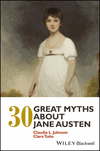JANE AUSTEN'S NOVELS ARE ABOUT GOOD MANNERS
Summary
This myth about good manners in Jane Austen's novels takes different forms and serves different purposes. Generally, “good manners” refers to specific decorums practiced in early-nineteenth-century England. Such are the manners viewers and reviewers of TV and movie productions of Austen's novels invoke when they observe how Austen's characters bow and curtsy upon entering or leaving a room. All societies generate forms and rituals that structure social behavior. In Austen's novels, as in virtually all nineteenth-century English novels, these forms and rituals are always functioning in the background, regulating the conduct of characters, shaping their expectations of each other, and making their intentions and feelings legible to each other and to us. If being a novelist of manners means both affirming the forms and rituals of a given society and also representing those forms and rituals as sufficient to account for the experiences of her characters, then Austen is not a novelist of manners.



